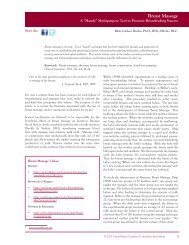Official Journal of the United States Lactation ... - Clinical Lactation
Official Journal of the United States Lactation ... - Clinical Lactation
Official Journal of the United States Lactation ... - Clinical Lactation
Create successful ePaper yourself
Turn your PDF publications into a flip-book with our unique Google optimized e-Paper software.
<strong>Clinical</strong> Tips<br />
Caring for Breast Pump Parts<br />
Kathleen Chiu, IBCLC, RLC 1<br />
Cleaning Breast Pump Parts<br />
Unless <strong>the</strong> kit is sterile, a member <strong>of</strong> <strong>the</strong> baby’s household<br />
should clean kit parts before <strong>the</strong> first use.(“Home<br />
germs are best germs.”) The pieces that should normally<br />
be washed include <strong>the</strong> milk storage containers (bottles),<br />
<strong>the</strong> flanges or breast shields, and <strong>the</strong> valves/<br />
membranes.<br />
Pump tubing only requires washing if it gets wet inside.<br />
Filters should not be washed ei<strong>the</strong>r. They are meant to<br />
shut-down if wet to stop fluid from getting inside <strong>the</strong><br />
pump and/or motor, and causing contamination and<br />
mold growth. This protects both mo<strong>the</strong>r and baby, and<br />
<strong>the</strong> pump. A wet filter may need several hours to dry, or<br />
may need to be replaced.<br />
For healthy, full-term babies <strong>the</strong> pump parts are:<br />
••<br />
Washed in hot, soapy water.<br />
••<br />
Rinsed in hot water.<br />
••<br />
Laid out to air dry on a clean towel.<br />
••<br />
Covered with ano<strong>the</strong>r clean towel.<br />
In addition:<br />
A bottle brush may be used on <strong>the</strong> milk-storage<br />
containers.<br />
••<br />
NEVER use a nipple brush on <strong>the</strong> valves/membranes.<br />
º º Be gentle with this part. They <strong>of</strong>ten have thin<br />
edges that are easily torn, frayed, or o<strong>the</strong>rwise<br />
damaged by sharp objects, including fingernails.<br />
Swish tubular (duckbill) valves in soapy water,<br />
and gently rub flat-valve membranes with <strong>the</strong><br />
fingertips, like cleaning a contact lens.<br />
••<br />
NEVER put <strong>the</strong> valves/membranes on “pegs” (like<br />
on a bottle/nipple drying rack) to air dry.<br />
º º The valves or membranes are sensitive pieces,<br />
and poking things in or through <strong>the</strong>m can warp<br />
or tear <strong>the</strong>m.<br />
1 amcbe@comcast.net<br />
º º Vulnerable (preterm, small for gestational age,<br />
ill) babies may require that <strong>the</strong> pump parts be<br />
sterilized in addition to washing.<br />
Sterilizing Pump Parts<br />
Start <strong>the</strong> water boiling first without placing anything else<br />
in <strong>the</strong> pot. Put sufficient water in <strong>the</strong> pot to allow <strong>the</strong><br />
pump pieces to be covered by several inches <strong>of</strong> water<br />
once <strong>the</strong>y are submerged.<br />
••<br />
Once <strong>the</strong> water is boiling, lower <strong>the</strong> heat until <strong>the</strong><br />
water is boiling s<strong>of</strong>tly.<br />
••<br />
Pad <strong>the</strong> inside <strong>of</strong> <strong>the</strong> pot with a cotton dish towel,<br />
washcloth, or diaper. This will prevent <strong>the</strong> pump<br />
parts from warping or melting from touching <strong>the</strong><br />
hot metal. The pad will also singe before <strong>the</strong> plastic,<br />
if <strong>the</strong> boiling pump parts are “forgotten,” and all <strong>the</strong><br />
water boils away.<br />
••<br />
Put <strong>the</strong> pump parts in, on top <strong>of</strong> your cotton-cloth<br />
padding, so that <strong>the</strong>y are completely immersed in <strong>the</strong><br />
boiling water.<br />
••<br />
SET A TIMER. It needs to be a loud, repetitive alarm<br />
(new parents are <strong>of</strong>ten overtired and forgetful).<br />
••<br />
When <strong>the</strong> timer alarm goes <strong>of</strong>f, shut <strong>of</strong>f <strong>the</strong> heat<br />
and allow <strong>the</strong> water and parts to cool <strong>of</strong>f to a safe<br />
temperature.<br />
••<br />
Use a set <strong>of</strong> tongs to remove <strong>the</strong> pump parts from<br />
<strong>the</strong> water.<br />
••<br />
Lay <strong>the</strong>m out to air dry on a clean towel.<br />
••<br />
Cover <strong>the</strong>m with a clean towel.<br />
••<br />
Once dry, parts can be stored in gallon zipper-top<br />
plastic bags.<br />
Common Concerns<br />
Dishwashers<br />
Share this:<br />
Pump parts can be cleaned in <strong>the</strong> dishwasher, but should<br />
not routinely be washed in one. Dishwashers use very<br />
harsh chemicals and very hot water, plus heat to dry, all<br />
<strong>of</strong> which will shorten <strong>the</strong> life <strong>of</strong> pump parts, especially<br />
<strong>the</strong> sensitive valves/membranes. Mo<strong>the</strong>rs who value convenience<br />
over money may want to use <strong>the</strong> dishwasher<br />
30 <strong>Clinical</strong> <strong>Lactation</strong> 2012, Vol. 3-1




